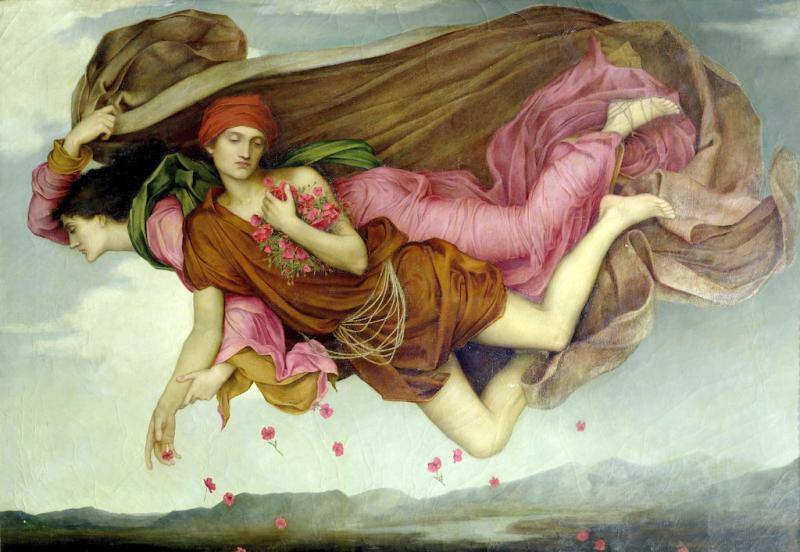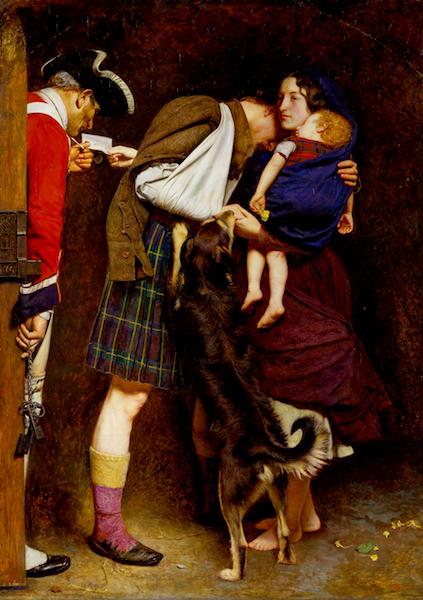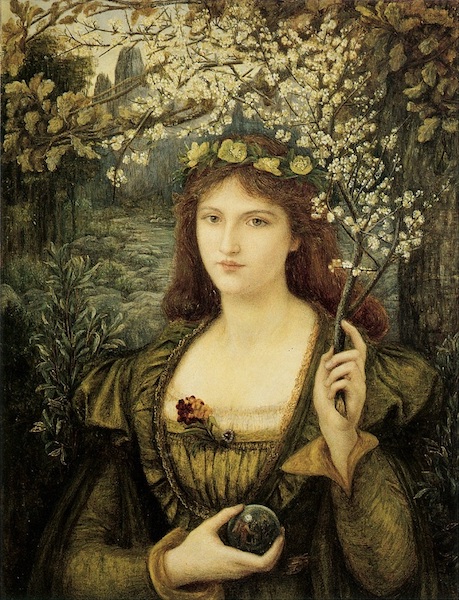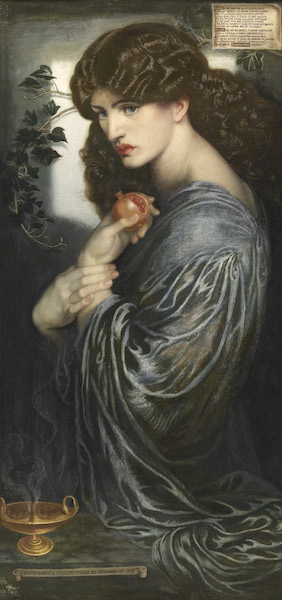Pre-Raphaelite Sisters, National Portrait Gallery review – a fascinating glimpse behind the scenes | reviews, news & interviews
Pre-Raphaelite Sisters, National Portrait Gallery review – a fascinating glimpse behind the scenes
Pre-Raphaelite Sisters, National Portrait Gallery review – a fascinating glimpse behind the scenes
Spotlight on the women and their role in the Brotherhood

Focusing on twelve women who played a key role in the lives of Pre-Raphaelite painters like Dante Gabriel Rossetti, John Everett Millais and William Holman Hunt, this timely exhibition begins with a whimper and ends with a bang. First up at the National Portrait Gallery is Effie Gray whose marriage to art critic, John Ruskin was annulled after six years for non-consummation.
Gray then married Millais and assumed the traditional role of supportive wife. This involved keeping house, bearing and bringing up eight children (I wonder if she ever regretted abandoning celibacy) and managing her husband’s business. She sourced costumes, found locations, effected sales and modelled for him.
 There she is in Order of the Release, 1853 (pictured right), posing as the wife of an imprisoned Jacobite Highlander. I like to imagine this brilliant composition as a reflection of her marriage. Standing barefoot on the stone floor, she is an unwavering pillar of strength. Having effected his release from jail, she stoically supports her wounded husband on one shoulder and her sleeping child on the other. Her actual role of multi-tasking wife would have required a similar degree of resourcefulness.
There she is in Order of the Release, 1853 (pictured right), posing as the wife of an imprisoned Jacobite Highlander. I like to imagine this brilliant composition as a reflection of her marriage. Standing barefoot on the stone floor, she is an unwavering pillar of strength. Having effected his release from jail, she stoically supports her wounded husband on one shoulder and her sleeping child on the other. Her actual role of multi-tasking wife would have required a similar degree of resourcefulness.
The exhibition ends with Evelyn De Morgan, a professional artist in whose household the boot was firmly on the other foot. De Morgan studied at the Slade School of Art, which had just opened its doors to female students, and won numerous prizes. She began exhibiting at the Grosvenor Gallery in 1877 and, for the next 30 years, sold enough paintings to support her husband, William and his pottery business.
Night and Sleep, 1878 (main picture) features a Pre-Raphaelite style beauty – chiselled features framed by a main of thick hair and slender limbs offset by the clinging folds of a wet-look gown. She is Night, drawing her cloak of darkness over the misty landscape below while, nestling beside her, Sleep scatters slumber-inducing poppies. The Pre-Raphaelites loved this kind of poetic sentiment, but De Morgan’s treatment is far from typical. Leading her androgynous helper by the hand, Night brings the day to a close with a gentle determination that suggests a more independent view of womanhood than was the norm.
The fortunes of the other Sisters lie somewhere between those of Gray and De Morgan. A famous beauty, Marie Spartali Stillman had all the attributes of a Pre-Raphaelite damsel. In a chalk drawing, Rossetti shows her with a main of lustrous red hair, clear green eyes, a long neck and sensuously pouting lips. She was also an artist and, in her 65 year career, produced 150 paintings which she showed at the Grosvenor Gallery, and in Rome and the United States where she travelled with her journalist husband, William.
 Madonna Pietra degli Scrovigni, 1884 (pictured left) features a pale young woman holding a sprig of flowering hawthorn; she is Sestina, the stone virgin from a poem by Dante – a favourite Pre-Raphaelite subject. Stillman also introduces a new kind of female, who is neither a femme fatale nor a wilting flower. Her Madonna returns our gaze with unflinching composure that, to a Victorian eye, must have been distinctly unnerving.
Madonna Pietra degli Scrovigni, 1884 (pictured left) features a pale young woman holding a sprig of flowering hawthorn; she is Sestina, the stone virgin from a poem by Dante – a favourite Pre-Raphaelite subject. Stillman also introduces a new kind of female, who is neither a femme fatale nor a wilting flower. Her Madonna returns our gaze with unflinching composure that, to a Victorian eye, must have been distinctly unnerving.
Joanna Boyce Wells was an aspiring painter, but she died at 30 after the birth of her third child. Painted in 1871, the year she died, her portrait of Fanny Eaton captures with enormous subtlety the fine features of the West Indian woman who modelled for several Pre-Raphaelite painters in the role of servant or exotic “other”. Wells’s last work was Thou Bird of God, an exquisite painting of an angel, which shows her promise as an artist.
Stillman’s cousin, Marie Zambaco modelled for Edward Burne Jones and they fell madly in love; in The Beguiling of Merlin, 1877 he portrays her as a temptress stealing his powers. She also studied at the Slade and became a sculptor, exhibiting at the Royal Academy and the Paris Salon; but all her work has been lost save for four portrait medallions she donated to the British Museum.
The Pre-Raphaelites were high-minded when it came to art, but in life they indulged in shenanigans. While they were embroiled in their affair, Burne Jones’s wife Georgiana entered a relationship with William Morris whose wife, Jane was in love with Rossetti. In 1877, Rossetti painted Jane as Persephone holding a pomegranate suggestively split open to reveal the red flesh (pictured below). According to the myth, Persephone ate six pomegranate seeds while being held captive in Hades, which condemned her to six months a year spent underground. Rossetti’s painting refers to the fact that Jane was similarly dividing her time between summers spent with him and winters with Morris.
 I would love to know more of the intrigues behind the paintings; occasionally you get glimpses. William Holman Hunt broke off his engagement of many years to Annie Miller because of her wilfulness and frivolity. In 1853 he cast her as a fallen woman in The Awakening Conscience, then in Il Dolce far Niente (The Sweetness of Doing Nothing) 1866, he portrays her as a feisty libertine, far too spirited (he must have thought) to be a trustworthy wife. So keen was he to be rid of her that he offered her assisted emigration, but she refused and went on to marry a well connected army officer !
I would love to know more of the intrigues behind the paintings; occasionally you get glimpses. William Holman Hunt broke off his engagement of many years to Annie Miller because of her wilfulness and frivolity. In 1853 he cast her as a fallen woman in The Awakening Conscience, then in Il Dolce far Niente (The Sweetness of Doing Nothing) 1866, he portrays her as a feisty libertine, far too spirited (he must have thought) to be a trustworthy wife. So keen was he to be rid of her that he offered her assisted emigration, but she refused and went on to marry a well connected army officer !
Pre-Raphaelite Sisters offers tantalising glimpses into the lives behind the pictures and presents these twelve women as real people. Don’t imagine, though, that it overturns the traditional view of women as subordinate to their menfolk. A banner at the entrance lists the proffered roles – model, wife, artist, muse – and the women are still defined largely in relation to the more famous men. De Morgan and Stillman are represented by only a few paintings and Jane Morris, a skilled calligrapher and needlewoman, by only one embroidery and a single text. It’s a welcome beginning, but I’d still like to see an exhibition which treats De Morgan, Stillman, Wells et al primarily as artists and provides a substantial overview of their work.
rating
Explore topics
Share this article
The future of Arts Journalism
You can stop theartsdesk.com closing!
We urgently need financing to survive. Our fundraising drive has thus far raised £49,000 but we need to reach £100,000 or we will be forced to close. Please contribute here: https://gofund.me/c3f6033d
And if you can forward this information to anyone who might assist, we’d be grateful.

Subscribe to theartsdesk.com
Thank you for continuing to read our work on theartsdesk.com. For unlimited access to every article in its entirety, including our archive of more than 15,000 pieces, we're asking for £5 per month or £40 per year. We feel it's a very good deal, and hope you do too.
To take a subscription now simply click here.
And if you're looking for that extra gift for a friend or family member, why not treat them to a theartsdesk.com gift subscription?
more Visual arts
 'We are bowled over!' Thank you for your messages of love and support
Much-appreciated words of commendation from readers and the cultural community
'We are bowled over!' Thank you for your messages of love and support
Much-appreciated words of commendation from readers and the cultural community
 Folkestone Triennial 2025 - landscape, seascape, art lovers' escape
Locally rooted festival brings home many but not all global concerns
Folkestone Triennial 2025 - landscape, seascape, art lovers' escape
Locally rooted festival brings home many but not all global concerns
 Sir Brian Clarke (1953-2025) - a personal tribute
Remembering an artist with a gift for the transcendent
Sir Brian Clarke (1953-2025) - a personal tribute
Remembering an artist with a gift for the transcendent
 Emily Kam Kngwarray, Tate Modern review - glimpses of another world
Pictures that are an affirmation of belonging
Emily Kam Kngwarray, Tate Modern review - glimpses of another world
Pictures that are an affirmation of belonging
 Kiefer / Van Gogh, Royal Academy review - a pairing of opposites
Small scale intensity meets large scale melodrama
Kiefer / Van Gogh, Royal Academy review - a pairing of opposites
Small scale intensity meets large scale melodrama
 Jenny Saville: The Anatomy of Painting, National Portrait Gallery review - a protégé losing her way
A brilliant painter in search of a worthwhile subject
Jenny Saville: The Anatomy of Painting, National Portrait Gallery review - a protégé losing her way
A brilliant painter in search of a worthwhile subject
 Abstract Erotic, Courtauld Gallery review - sculpture that is sensuous, funny and subversive
Testing the boundaries of good taste, and winning
Abstract Erotic, Courtauld Gallery review - sculpture that is sensuous, funny and subversive
Testing the boundaries of good taste, and winning
 Edward Burra, Tate Britain review - watercolour made mainstream
Social satire with a nasty bite
Edward Burra, Tate Britain review - watercolour made mainstream
Social satire with a nasty bite
 Ithell Colquhoun, Tate Britain review - revelations of a weird and wonderful world
Emanations from the unconscious
Ithell Colquhoun, Tate Britain review - revelations of a weird and wonderful world
Emanations from the unconscious
 Rachel Jones: Gated Canyons, Dulwich Picture Gallery review - teeth with a real bite
Mouths have never looked so good
Rachel Jones: Gated Canyons, Dulwich Picture Gallery review - teeth with a real bite
Mouths have never looked so good
 Yoshitomo Nara, Hayward Gallery review - sickeningly cute kids
How to make millions out of kitsch
Yoshitomo Nara, Hayward Gallery review - sickeningly cute kids
How to make millions out of kitsch
 Hamad Butt: Apprehensions, Whitechapel Gallery review - cool, calm and potentially lethal
The YBA who didn’t have time to become a household name
Hamad Butt: Apprehensions, Whitechapel Gallery review - cool, calm and potentially lethal
The YBA who didn’t have time to become a household name

Add comment